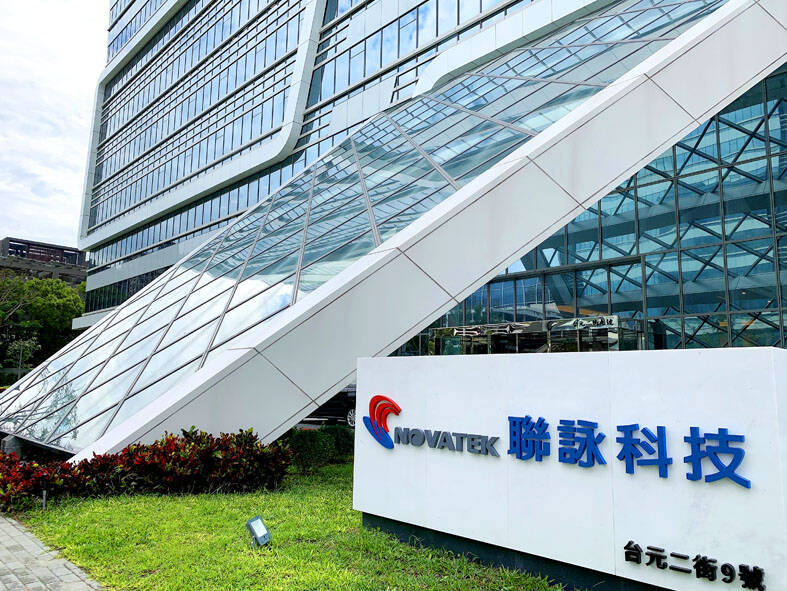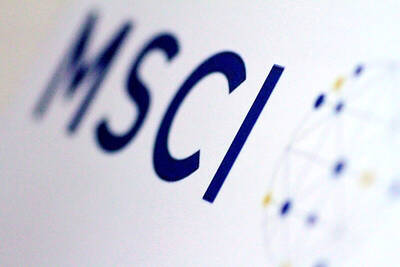Novatek Microelectronics Corp (聯詠), which designs display driver chips used in TVs, PCs and smartphones, yesterday said its revenue this quarter would shrink about 9 percent sequentially, due to the double impact from New Taiwan dollar’s appreciation and softening demand.
Customers are shifting to a conservative mode and cautious about placing new orders in the third quarter as tariff-related front-loading demand is ebbing, Novatek said, adding that consumer electronics demand in China is cooling following the expiration of Beijing’s subsidies on new purchases.
Additionally, the company’s revenue, which is denominated in NT dollars, would be fully impacted by the appreciation of the local currency, as a majority of its products are quoted in US dollars, Novatek president Steve Wang (王守仁) said in an online earnings conference.

Photo: Grace Hung, Taipei Times
“Overall, we expect Novatek’s revenue will continue its slide during the third quarter,” Wang said. “For the fourth quarter, we are closely monitoring how the US tariffs would come into play, since tariff rates are mostly determined.”
Revenue this quarter is expected to dip to between NT$23.7 billion and NT$24.7 billion (US$790.3 million to US$823.6 million), compared with NT$26.7 billion in the second quarter, he said.
The revenue decline would be across-the-board with all product lines affected, he said.
The large display driver chips used in TVs and PCs would see the deepest decline in revenue on a quarterly basis, he added.
That would be followed by chips and timing controllers for TVs and monitors, while mid-and-small-sized display driver chips mainly used in mobile phones and tablets would see the mildest decline, Wang said.
Mid-and-small-sized display driver chips were the biggest revenue contributor last quarter, accounting for 40 percent, followed by TV chips and large display driver chips.
Novatek failed to meet its gross margin target of between 37 percent and 40 percent for last quarter, as the dramatic appreciation of the NT dollar erased 2.5 percentage points from its margin, the company said.
The company is assuming that the currency would strengthen 5 percent to NT$29.5 against the US dollar this quarter, extending its upward trend in the second quarter.
Gross margin this quarter is to be between 34 percent and 37 percent, compared with 36.3 percent in the second quarter, Wang said.
Net profit last quarter dipped about 29 percent sequentially to NT$3.74 billion from NT$5.26 billion, hitting the lowest level in about 18 quarters, Novatek said.
That represented an annual decline of 30.61 percent from NT$5.39 billion.
Earnings per share dropped to NT$6.14 from NT$8.65 in the second quarter and NT$8.86 a year earlier.
The firm booked NT$669 million in foreign exchange losses last quarter, leading to a non-operating loss of NT$221 million.

PERSISTENT RUMORS: Nvidia’s CEO said the firm is not in talks to sell AI chips to China, but he would welcome a change in US policy barring the activity Nvidia Corp CEO Jensen Huang (黃仁勳) said his company is not in discussions to sell its Blackwell artificial intelligence (AI) chips to Chinese firms, waving off speculation it is trying to engineer a return to the world’s largest semiconductor market. Huang, who arrived in Taiwan yesterday ahead of meetings with longtime partner Taiwan Semiconductor Manufacturing Co (TSMC, 台積電), took the opportunity to clarify recent comments about the US-China AI race. The Nvidia head caused a stir in an interview this week with the Financial Times, in which he was quoted as saying “China will win” the AI race. Huang yesterday said

Nissan Motor Co has agreed to sell its global headquarters in Yokohama for ¥97 billion (US$630 million) to a group sponsored by Taiwanese autoparts maker Minth Group (敏實集團), as the struggling automaker seeks to shore up its financial position. The acquisition is led by a special purchase company managed by KJR Management Ltd, a Japanese real-estate unit of private equity giant KKR & Co, people familiar with the matter said. KJR said it would act as asset manager together with Mizuho Real Estate Management Co. Nissan is undergoing a broad cost-cutting campaign by eliminating jobs and shuttering plants as it grapples

The Chinese government has issued guidance requiring new data center projects that have received any state funds to only use domestically made artificial intelligence (AI) chips, two sources familiar with the matter told Reuters. In recent weeks, Chinese regulatory authorities have ordered such data centers that are less than 30 percent complete to remove all installed foreign chips, or cancel plans to purchase them, while projects in a more advanced stage would be decided on a case-by-case basis, the sources said. The move could represent one of China’s most aggressive steps yet to eliminate foreign technology from its critical infrastructure amid a

MORE WEIGHT: The national weighting was raised in one index while holding steady in two others, while several companies rose or fell in prominence MSCI Inc, a global index provider, has raised Taiwan’s weighting in one of its major indices and left the country’s weighting unchanged in two other indices after a regular index review. In a statement released on Thursday, MSCI said it has upgraded Taiwan’s weighting in the MSCI All-Country World Index by 0.02 percentage points to 2.25 percent, while maintaining the weighting in the MSCI Emerging Markets Index, the most closely watched by foreign institutional investors, at 20.46 percent. Additionally, the index provider has left Taiwan’s weighting in the MSCI All-Country Asia ex-Japan Index unchanged at 23.15 percent. The latest index adjustments are to